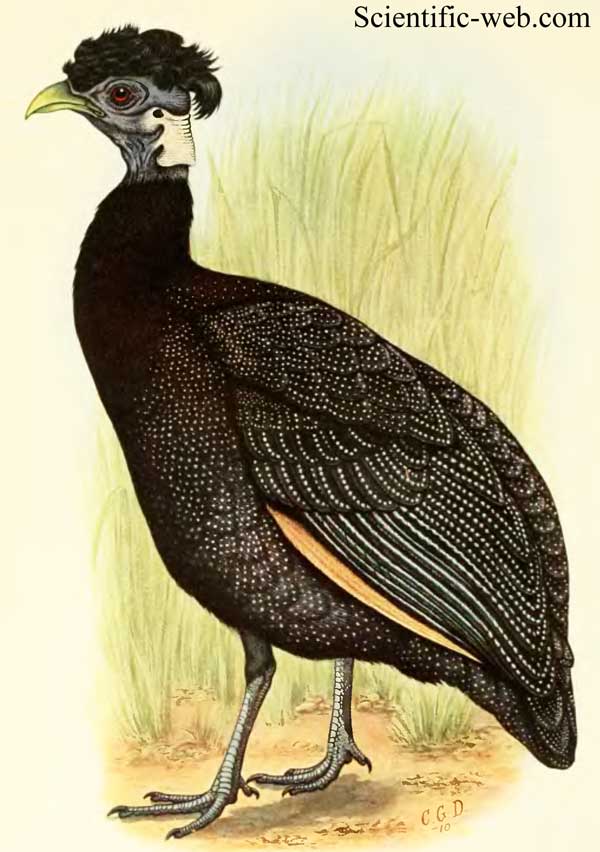
Guttera pucherani
Superregnum: Eukaryota
Regnum: Animalia
Subregnum: Eumetazoa
Cladus: Bilateria
Cladus: Nephrozoa
Superphylum: Deuterostomia
Phylum: Chordata
Cladus: Craniata
Subphylum: Vertebrata
Infraphylum: Gnathostomata
Superclassis: Tetrapoda
Cladus: Reptiliomorpha
Cladus: Amniota
Classis: Reptilia
Cladus: Eureptilia
Cladus: Romeriida
Subclassis: Diapsida
Cladus: Sauria
Infraclassis: Archosauromorpha
Cladus: Crurotarsi
Divisio: Archosauria
Subsectio: Ornithodira
Subtaxon: Dinosauromorpha
Cladus: Dinosauria
Ordo: Saurischia
Cladus: Theropoda
Cladus: Neotheropoda
Infraclassis: Aves
Cladus: Euavialae
Cladus: Avebrevicauda
Cladus: Pygostylia
Cladus: Ornithothoraces
Cladus: Euornithes
Cladus: Ornithuromorpha
Cladus: Ornithurae
Cladus: Carinatae
Parvclassis: Neornithes
Cohors: Neognathae
Cladus: Galloanseres
Ordo: Galliformes
Familia: Numididae
Genus: Guttera
Species: Guttera pucherani
Name
Guttera pucherani (Hartlaub, 1861)
Vernacular names
English: Crested Guineafowl
magyar: Bóbitás gyöngytyúk, kontyos gyöngytyúk
Nederlands: Kroonparelhoen
português: Fraca-de-cristata
svenska: Tofspärlhöna
The crested guineafowl (Guttera pucherani) is a member of the Numididae, the guineafowl bird family. It is found in open forest, woodland and forest-savanna mosaics in sub-Saharan Africa.
Description
It has a total length around 50 cm (20 in) and weighs 721–1,543 g (1.590–3.402 lb).[2] The plumage is overall blackish with dense white spots. It has a distinctive black crest on the top of its head, the form of which varies from small curly feathers to down depending upon subspecies, and which easily separates it from all other species of guineafowl, except the plumed guineafowl. The names "crested" and "plumed" are often misapplied across the species.
Breeding
The species is monogamous with probable strong and long-lasting pair bonds. Courtship feeding is common, the author having seen a captive male run 5–10 m to the hen to present some particular morsel. The nest is a well-hidden scrape in long grass or under a bush; eggs vary from nearly white to buff and a clutch is usually around four or five.
Intraspecific taxonomy
G. p. pucherani in Arabuko Sokoke N.P., eastern Kenya
G. p. edouardi in Hluhluwe–iMfolozi Park, eastern South Africa
G. p. edouardi in Somkhanda Game Reserve, eastern South Africa
The intraspecific taxonomy of the crested guineafowl has been subject to considerable debate, but most recent authorities accept five subspecies (e.g. I. Martinez in Handbook of the Birds of the World [HBW], 1994). Visual differences between the subspecies, in addition to the form of the crest, are in the colour and position of any patches on the otherwise grey-blue neck and face. Such patches vary from almost white to yellow, to red. The nominate subspecies is found in East Africa from Somalia to Tanzania, and is distinctive with a grey-blue neck and extensive red to the face. It was formerly considered a monotypic species,[3] the Kenya crested guineafowl, in which case the remaining subspecies, which are found in southern, central, and west Africa, retain the common name crested guineafowl, but under the scientific name Guttera edouardi. They have a bluish face and neck, though the nape is very pale greyish (almost white) in some subspecies and the throat is red in others.
Subspecies
The five recognized subspecies are:
G. p. barbata (Ghigi, 1905) – Malawi crested guineafowl – southeastern Tanzania to eastern Mozambique and Malawi
G. p. edouardi (Hartlaub, 1867) - Edward's crested guineafowl – eastern Zambia to Mozambique and eastern South Africa
G. p. pucherani (Hartlaub, 1861) – Kenya crested guineafowl – Somalia to Tanzania, Zanzibar, and Tumbatu Island
G. p. sclateri (Reichenow, 1898) – Sclater's crested guineafowl – northwestern Cameroon
G. p. verreauxi (Elliot, 1870) – Lindi crested guineafowl – Guinea-Bissau to western Kenya, Angola, and Zambia
References
BirdLife International (2016). "Guttera pucherani". IUCN Red List of Threatened Species. 2016: e.T22725212A94887385. doi:10.2305/IUCN.UK.2016-3.RLTS.T22725212A94887385.en. Retrieved 19 November 2021.
CRC Handbook of Avian Body Masses by John B. Dunning Jr. (Editor). CRC Press (1992), ISBN 978-0-8493-4258-5.
HBW, 1994
Retrieved from "http://en.wikipedia.org/"
All text is available under the terms of the GNU Free Documentation License

